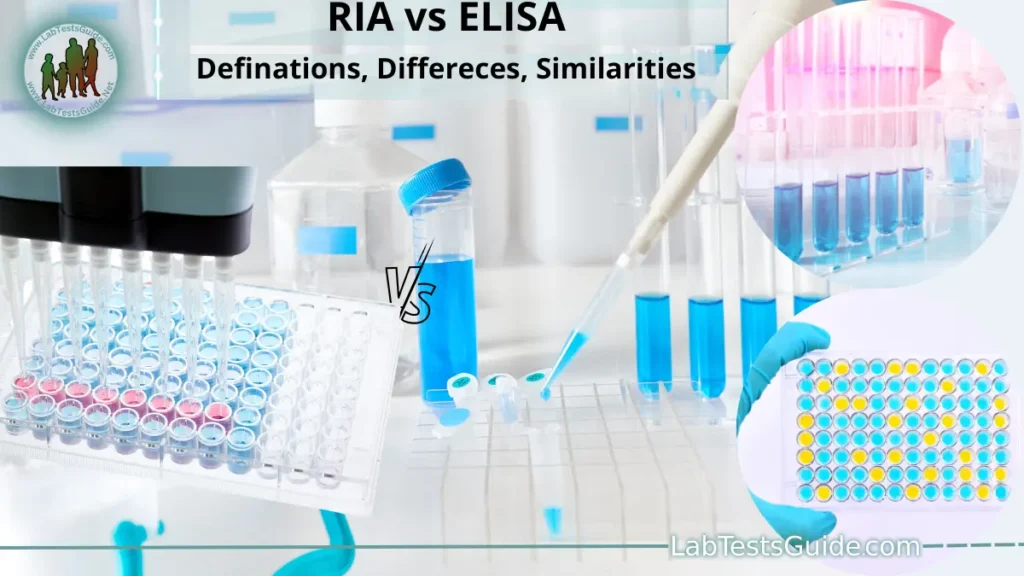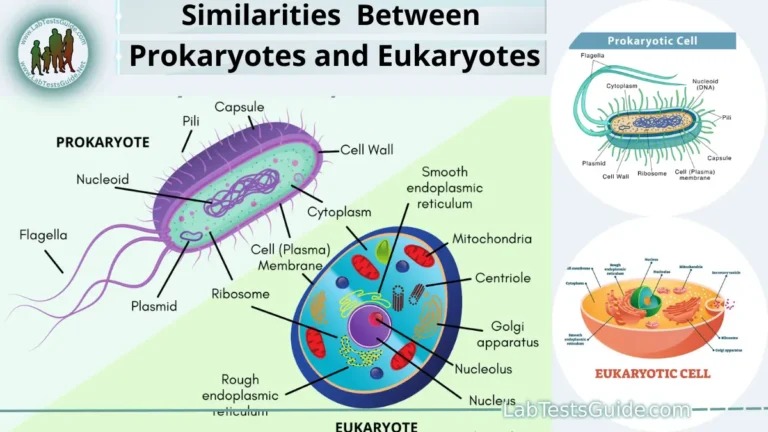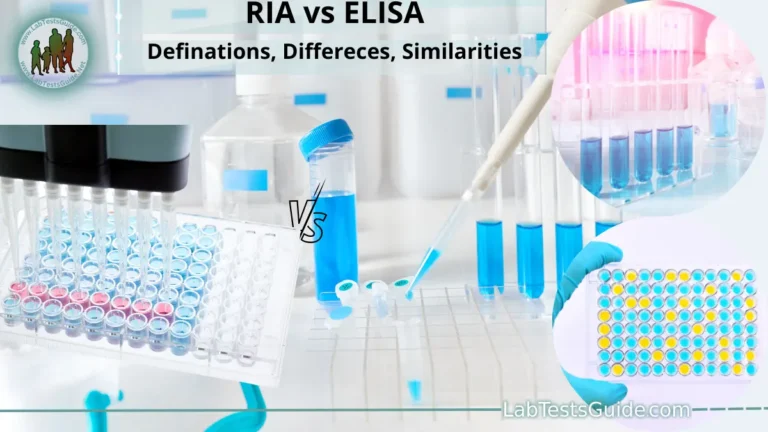RIA vs ELISA – Radioimmunoassay (RIA) and enzyme-linked immunosorbent assay (ELISA) are both immunoassay techniques that are used to measure the presence and concentration of specific antigens or antibodies in biological fluids.

What is RIA?
RIA stands for Radioimmunoassay. It is a laboratory technique used to measure the concentration of specific substances, such as hormones, antigens, or antibodies, in a biological sample. RIA involves the use of radioactive-labeled substances (tracers) that compete with the unlabeled substances in the sample for binding to specific antibodies. The amount of radioactivity detected in the bound fraction is inversely proportional to the concentration of the target substance in the sample, allowing for precise quantification.
What is ELISA?
ELISA stands for Enzyme-linked immunosorbent assay. It is a widely used laboratory technique that detects and quantifies specific substances, such as antigens or antibodies, in biological samples. ELISA involves immobilizing either the target antigen or antibody on a solid surface, such as a microplate, and then using an enzyme-linked secondary antibody or antigen to create a detectable signal. The enzyme catalyzes a reaction with a substrate, producing a color or fluorescence that is directly proportional to the amount of the target substance in the sample, allowing for accurate measurement.
Definations:
RIA Defination:
Radioimmunoassay uses radioactive isotopes as markers to quantify the amount of antigen or antibody in a sample. It involves the competition between a radioactive-labeled antigen (tracer) and the unlabeled antigen in the sample for binding to specific antibodies.
ELISA Defination:
Enzyme-linked immunosorbent assay employs an enzyme-linked antibody or antigen to produce a detectable signal. The enzyme catalyzes a colorimetric or fluorescent reaction when it binds to the target antigen or antibody.
Principles:
Principle of RIA:
The principle of RIA (Radioimmunoassay) is based on competitive binding. It utilizes radioactive-labeled substances (tracers) that compete with the unlabeled substances in the sample for binding to specific antibodies. The amount of radioactivity detected in the bound fraction is inversely proportional to the concentration of the target substance in the sample, allowing for precise quantification.
Principle of ELISA:
The principle of ELISA (Enzyme-linked immunosorbent assay) is based on immunoassay. It involves immobilizing either the target antigen or antibody on a solid surface, such as a microplate, and then using an enzyme-linked secondary antibody or antigen to create a detectable signal. The enzyme catalyzes a reaction with a substrate, producing a color or fluorescence that is directly proportional to the amount of the target substance in the sample, allowing for accurate measurement.
Sensitivity Comparison:
RIA Sensitivity:
RIA has been considered the gold standard for sensitivity, capable of detecting very low concentrations of analytes in the range of picograms or femtograms. The use of radioactive tracers and specialized equipment has allowed RIA to achieve high sensitivity levels.
ELISA Sensitivity:
Advancements in ELISA technology have significantly improved its sensitivity over the years. Modern ELISAs can now detect analytes in the low picogram range, making them comparable to RIA in terms of sensitivity.
Pros and Cons of RIA and ELISA:
RIA offers high sensitivity and precise quantification but comes with safety and cost concerns related to radioactive materials. On the other hand, ELISA provides a safer, cost-effective, and versatile alternative, suitable for various applications, with slightly reduced sensitivity in some cases. The choice between RIA and ELISA depends on the specific needs, resources, and safety considerations of the assay.
RIA Advantages:
- High Sensitivity: RIA has historically been known for its exceptional sensitivity, allowing the detection of very low concentrations of analytes in biological samples.
- Precise Quantification: RIA provides accurate and reliable quantitative results, making it suitable for research and diagnostic applications requiring precise measurements.
- Well-established Technique: RIA has been used extensively for decades, and there is a wealth of existing knowledge and literature supporting its use.
ELISA Advantages:
- Safety: ELISA is safer to use compared to RIA since it does not involve radioactive materials, reducing the risks associated with handling hazardous substances.
- Cost-effective: ELISA is generally more cost-effective than RIA, as it does not require radioactive isotopes and associated equipment.
- Versatility: ELISA can be adapted to detect a wide range of analytes, including antigens, antibodies, hormones, and more.
- Ease of Automation: ELISA is well-suited for automation, with commercial ELISA kits readily available for streamlined and standardized procedures.
RIA Disadvantages:
- Radioactive Safety Concerns: The use of radioactive isotopes in RIA raises safety issues, requiring specialized handling, disposal, and safety measures to prevent radiation exposure.
- Expensive: RIA can be costly due to the need for radioactive materials and specialized equipment.
- Limited Automation: Automation of RIA can be challenging due to the involvement of radioactive substances.
ELISA Disadvantages:
- Sensitivity Variability: While ELISA has significantly improved in sensitivity, it may still slightly lag behind RIA in some cases, particularly for ultra-low concentration analytes.
- Potential Cross-reactivity: ELISA’s reliance on antibodies for detection can lead to cross-reactivity issues, affecting the specificity of the assay.
- Complex Sample Matrix: ELISA performance can be affected by complex biological matrices, requiring appropriate sample preparation and optimization.
Differences Between RIA and ELISA:
12 key differences between RIA (Radioimmunoassay) and ELISA (Enzyme-linked immunosorbent assay):
- Principle:
- RIA: RIA is based on competitive binding between radioactive-labeled tracers and unlabeled antigens or antibodies for specific binding sites on antibodies or antigens.
- ELISA: ELISA relies on the specific binding of an antigen or antibody to an immobilized counterpart on a solid surface, followed by the detection of the bound complex using an enzyme-linked secondary antibody or antigen.
- Detection Method:
- RIA: RIA uses radioactivity measurement from the bound radioactive tracers to quantify the target analyte.
- ELISA: ELISA detects the analyte by measuring the color or fluorescence generated from the enzymatic reaction on the solid surface.
- Sensitivity:
- RIA: Historically, RIA has been more sensitive than ELISA, capable of detecting very low concentrations in the picogram or femtogram range.
- ELISA: Modern ELISAs have improved sensitivity and can now achieve similar levels of detection as RIA for most analytes.
- Safety:
- RIA: RIA involves the use of radioactive isotopes, leading to safety concerns and requiring special handling and disposal procedures.
- ELISA: ELISA does not require radioactive materials, making it safer and more accessible for laboratories.
- Automation:
- RIA: Automation of RIA can be challenging due to the use of radioactive materials, limiting the extent of full automation.
- ELISA: ELISA is well-suited for automation, with many commercial kits available for streamlined and high-throughput assays.
- Cost:
- RIA: RIA can be more expensive due to the need for radioactive isotopes and specialized equipment.
- ELISA: ELISA is generally more cost-effective, especially with advancements in enzyme-based detection systems and availability of commercial kits.
- Antibody Cross-reactivity:
- RIA: Cross-reactivity with structurally similar substances can sometimes lead to false results.
- ELISA: ELISA can also experience cross-reactivity, affecting the assay’s specificity, but it is less pronounced than in RIA.
- Sample Preparation:
- RIA: RIA often requires laborious and time-consuming sample preparation steps.
- ELISA: ELISA sample preparation is typically simpler and more straightforward.
- Reagents and Protocol:
- RIA: RIA requires specific radioactive reagents and protocols for labeling tracers and performing assays.
- ELISA: ELISA uses enzyme-linked antibodies or antigens as reagents, and protocols are well-established and standardized.
- Assay Time:
- RIA: RIA assays can take longer due to radioactivity measurement and sample preparation steps.
- ELISA: ELISA assays are relatively faster, with results achievable within a few hours.
- Matrix Effect:
- RIA: The complex biological matrix can interfere with the accuracy of RIA results, requiring careful validation and optimization.
- ELISA: ELISA can also be affected by sample matrix, but optimization strategies are available to mitigate these effects.
- Applications:
- RIA: RIA has a historical significance and is still used in specific cases, such as in some hormone assays.
- ELISA: ELISA is widely used for various applications, including diagnostics, research, and drug development, due to its versatility and ease of use.
Table of Differences:
| Key Point | RIA | ELISA |
|---|---|---|
| Principle | Competitive binding using radioactive-labeled tracers and antibodies/antigens | Immunoassay using immobilized antibodies/antigens and enzyme-linked detection |
| Detection Method | Radioactivity measurement | Colorimetric or fluorescent signal |
| Sensitivity | Historically high (picogram/femtogram range) | Modern ELISAs comparable (low picogram range) |
| Safety | Involves radioactive isotopes, safety concerns | Safer, no radioactive materials used |
| Automation | Limited automation due to radioactive materials | Well-suited for automation with commercial kits |
| Cost | More expensive (radioactive reagents, specialized equipment) | Generally cost-effective, especially with kits |
| Antibody Cross-reactivity | Potential cross-reactivity issues | Less pronounced cross-reactivity |
| Sample Preparation | Laborious and time-consuming | Simpler and more straightforward |
| Reagents and Protocol | Specific radioactive reagents and protocols | Enzyme-linked reagents, well-established protocols |
| Assay Time | Longer due to radioactivity measurement | Faster with results achievable within a few hours |
| Matrix Effect | Complex matrix can interfere with results | Can be affected, but mitigation strategies exist |
| Applications | Still used in some hormone assays | Widely used in diagnostics, research, and more |
Similarities Between RIA and ELISA:
12 similarities between RIA (Radioimmunoassay) and ELISA (Enzyme-linked immunosorbent assay):
- Immunoassay Techniques: Both RIA and ELISA are immunoassay techniques used to detect and quantify specific substances, such as antigens, antibodies, hormones, or other proteins, in biological samples.
- Antibody-Antigen Interactions: Both assays rely on the specific interactions between antibodies and antigens for detection and quantification of the target analytes.
- Solid Phase: Both RIA and ELISA involve the use of a solid phase for the immobilization of antibodies or antigens. In RIA, the solid phase is usually a plastic tube, while in ELISA, it is a microplate.
- Competitive Binding: Both methods utilize the principle of competitive binding, where labeled and unlabeled substances compete for limited binding sites on the antibodies or antigens.
- Quantitative Results: Both RIA and ELISA provide quantitative results, allowing researchers and clinicians to measure the exact concentration of the target analyte in the sample.
- Detection Systems: Both assays utilize detection systems to measure the presence of bound antibodies or antigens. RIA uses radioactivity measurement, and ELISA uses colorimetric or fluorescent signals.
- Calibration Curves: Both RIA and ELISA require calibration curves to convert signal intensities into concentration values of the target analyte.
- Specificity: Both methods are highly specific, as they rely on the specific binding between antibodies and antigens, ensuring accurate identification of the target analyte.
- Standard Controls: Both assays use standard controls of known concentrations to validate and ensure the accuracy and precision of the assay.
- Common Applications: RIA and ELISA are widely used in research, clinical diagnostics, drug development, and other fields to study a variety of biomolecules and diseases.
- Data Analysis: Both RIA and ELISA data are typically analyzed using software or specific algorithms to calculate concentrations and generate results.
- Sensitivity Improvements: Both methods have benefited from technological advancements over time, improving their sensitivity and expanding their applications in various fields.
Table of Similarities:
| Key Points | RIA | ELISA |
|---|---|---|
| Immunoassay Technique | Yes | Yes |
| Antibody-Antigen | Reliance on specific interactions between antibodies and antigens | Reliance on specific interactions between antibodies and antigens |
| Solid Phase | Use of a solid phase (e.g., plastic tube) for immobilization | Use of a solid phase (e.g., microplate) for immobilization |
| Competitive Binding | Principle of competitive binding | Principle of competitive binding |
| Quantitative Results | Provides quantitative results | Provides quantitative results |
| Detection Systems | Utilizes detection systems to measure bound antibodies or antigens | Utilizes detection systems to measure bound antibodies or antigens |
| Calibration Curves | Requires calibration curves for converting signal intensities into concentration values | Requires calibration curves for converting signal intensities into concentration values |
| Specificity | Highly specific assay | Highly specific assay |
| Standard Controls | Uses standard controls for assay validation | Uses standard controls for assay validation |
| Applications | Widely used in research, clinical diagnostics, and more | Widely used in research, clinical diagnostics, and more |
| Data Analysis | Data analyzed with specific software or algorithms | Data analyzed with specific software or algorithms |
| Sensitivity | Benefitted from technological advancements, improving sensitivity | Benefitted from technological advancements, improving sensitivity |
FAQs:
1. What is RIA?
RIA is a laboratory technique used to measure the concentration of specific substances, such as hormones, antigens, or antibodies, in a biological sample. It involves using radioactive-labeled substances (tracers) that compete with the unlabeled substances in the sample for binding to specific antibodies. The amount of radioactivity detected in the bound fraction is inversely proportional to the concentration of the target substance in the sample, enabling precise quantification.
2. What is ELISA?
ELISA is a widely used laboratory technique that detects and quantifies specific substances, such as antigens or antibodies, in biological samples. ELISA involves immobilizing either the target antigen or antibody on a solid surface, such as a microplate, and then using an enzyme-linked secondary antibody or antigen to create a detectable signal. The enzyme catalyzes a reaction with a substrate, producing a color or fluorescence that is directly proportional to the amount of the target substance in the sample, allowing for accurate measurement.
3. What are the main differences between RIA and ELISA?
The main differences between RIA and ELISA lie in their principles, detection methods, safety concerns, automation potential, cost, sensitivity, and applications. RIA uses radioactive tracers for detection, while ELISA relies on enzyme-linked antibodies. ELISA is generally safer, more cost-effective, and better suited for automation compared to RIA.
4. Which method is more sensitive: RIA or ELISA?
Historically, RIA has been known for higher sensitivity. However, modern ELISAs have significantly improved sensitivity and can now achieve similar levels of detection as RIA for most analytes, especially in the low picogram range.
5. Is RIA safe to use in a laboratory setting?
RIA involves the use of radioactive isotopes, which raises safety concerns. Proper handling, storage, and disposal procedures are necessary to prevent radiation exposure, making it more challenging to implement safely compared to ELISA.
6. Are there any safety concerns with ELISA?
ELISA does not involve radioactive materials, making it safer than RIA. However, standard laboratory safety practices should still be followed, especially when handling biological samples and chemicals.
7. Can ELISA be automated?
Yes, ELISA is well-suited for automation. Commercial ELISA kits are readily available, and automated systems can perform high-throughput testing efficiently.
8. Which assay is more cost-effective: RIA or ELISA?
ELISA is generally more cost-effective than RIA since it does not require radioactive materials and specialized equipment.
9. What are the typical applications of RIA and ELISA?
RIA has been historically used in hormone assays and research. ELISA finds applications in diagnostics, research, drug development, and more due to its versatility and ease of use.
10. Can ELISA detect antigens and antibodies?
Yes, ELISA can detect both antigens and antibodies, depending on the design of the assay. Direct ELISA detects antigens, while indirect ELISA detects antibodies.
11. How long does it take to perform an RIA or ELISA assay?
The time required to perform an RIA or ELISA assay can vary depending on the specific protocol and the number of samples being analyzed. Generally, ELISA assays are faster, with results achievable within a few hours, while RIA assays can take longer due to radioactivity measurement and sample preparation steps.
12. Can ELISA be used for point-of-care testing?
Yes, ELISA can be adapted for point-of-care testing when using portable or rapid ELISA kits. These kits allow for quick and on-site detection of specific analytes, making them suitable for certain diagnostic applications.
Conclusion:
In conclusion, both RIA (Radioimmunoassay) and ELISA (Enzyme-linked immunosorbent assay) are valuable immunoassay techniques used to detect and quantify specific substances in biological samples. RIA historically offered higher sensitivity but came with safety and cost concerns due to the use of radioactive materials. ELISA, on the other hand, has caught up in sensitivity and is now a safer, more cost-effective, and versatile alternative. The choice between RIA and ELISA depends on specific needs, resources, and the presence of radioactive materials, making each method suitable for various research, clinical, and diagnostic applications.
Possible References Used






